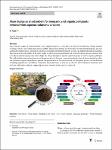Item Infomation
Full metadata record
| DC Field | Value | Language |
|---|---|---|
| dc.contributor.author | Pająk, M. | - |
| dc.date.accessioned | 2023-10-03T02:52:54Z | - |
| dc.date.available | 2023-10-03T02:52:54Z | - |
| dc.date.issued | 2023 | - |
| dc.identifier.uri | https://link.springer.com/article/10.1007/s13762-023-04854-4 | - |
| dc.identifier.uri | https://dlib.phenikaa-uni.edu.vn/handle/PNK/9407 | - |
| dc.description | CC-BY | vi |
| dc.description.abstract | One of the first stages of water treatment is the coagulation process, a side effect of which is the formation of huge amounts of sludge, which is most often deposited in landfills. The residues formed as a by-product in water treatment plants are characterized by high porosity, irregularity and loose structure with limited strength, so they can exhibit adsorption properties. This article reviews the ability of Al-based sludge to adsorb inorganic pollutants and textile dyes from aqueous solutions. Due to its physicochemical properties, alum sludge has a high adsorption capacity against inorganic as well as organic pollutants. The collected literature review focuses on the presentation of the most common directions of use of these materials as effective adsorbents against the pollutants present, the presentation of the conditions for the adsorption process, the mechanisms of binding of pollutants. | vi |
| dc.language.iso | en | vi |
| dc.publisher | Springer | vi |
| dc.subject | aqueous solutions | vi |
| dc.subject | adsorbent for inorganic | vi |
| dc.title | Alum sludge as an adsorbent for inorganic and organic pollutants removal from aqueous solutions: a review | vi |
| dc.type | Book | vi |
| Appears in Collections | ||
| OER - Khoa học môi trường | ||
Files in This Item:

